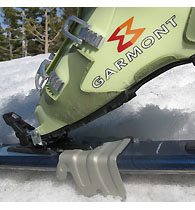TECH TIP: Ski Crampons - Wings of Steel
By: Craig Dostie & Bela G. Vadasz
One of the most overlooked pieces of equipment for ski mountaineers is the simple, but effective ski crampon. Like boot crampons for mountaineers, these are metal teeth that you affix to your feet, in this case your skis, for extreme grip. Turn dicey, nervous sections of a climb into a casual stroll with the confidence of spiderman.
 The most obvious use for them is while traversing steep slopes of firm snow, or skinning up early morning frozen corn snow. Ski crampons increase grip on the latter, and security on those sketchy steep traverses. The most obvious use for them is while traversing steep slopes of firm snow, or skinning up early morning frozen corn snow. Ski crampons increase grip on the latter, and security on those sketchy steep traverses.
Without them we are usually forced to change modes from skinning to booting, and usually just for a short section. Changing gears costs valuable time that is more easily dealt with by simply adding or removing ski crampons.
Less understood is their versatility beyond the grip they provide on firm snow. Quite often they help when traversing overripe corn snow where your skins grip the surface, but the corn layer itself slides on the bed surface. Ski crampons give solid edge grip in this situation, with nary an increase in drag.
There are basically two types of ski crampons. Fixed and pivoting. Fixed crampons are held rigidly to your skis. They are always engaged, whether you lift your foot or not. This can increase drag if the snow is very firm, but they also deliver a confidence you can always rely on. The reality is, the increase in drag is usually hardly noticeable, while the increase in security, highly desired.
Many prefer a pivoting crampon that lifts with your foot. These offer the possibility of less drag over icy sections, but at the risk of disengaging the teeth while your heel is lifted. In some situations, that may not be advisable. With pivoting ski crampons, you need to remember that they won't penetrate as deeply when you're climbing with heel elevators extended.
One of the biggest problems with ski crampons is knowing when to carry them. In wintry powder conditions it is rare to need them. However, even in midwinter skinning up windswept ridges can benefit from having ski crampons. They weigh little, so the decision to carry them or not depends on available space in your pack and how well you anticipate their use based on snow conditions. Typically they're more useful in spring conditions, especially with modern fat skis or splitboards where holding an edge is more difficult with a wider platform.
When you do carry them, don't hesitate to put them on early, before you really need them. With ski crampons on, try to lift your skis as little as possible while striding. If the snow dictates, press aggressively to set them in the snow. Using ski crampons allows you to save energy by gaining security. Added to full width climbing skins, you'll feel like you're climbing with four wheel drive and studded snow tires.
To save space, store them bottom-to-bottom with your folded skins in between, then slip the whole unit into your skin bag. You'll hardly know they are there.
Keep in mind that ski crampons can get you up some pretty steep and firm slopes where, if you do slip, it would be a "wild ride." Use good judgment, consider your self-arrest options and/or a rope belay if necessary. They are just one more tool to add to your bag of tricks to handle "all conditions and all terrain."
The following manufacturers of backcountry bindings offer optional ski crampons for their bindings.
Manufacturer Widths Available:

7tm
85mm, 105mm
|

B&D
80, 90, 100, 105, 110, 120mm
|

Black Diamond
82mm, 100mm
|

Dynafit
92mm
|

Fritschi
79mm, 100mm
|

G3
85mm, 110mm
|

Marker
92mm, 113mm
|

Silvretta
82mm
|

Voile
92mm, 112mm
|
For telemark skiers using bindings from 22 Designs or Rottefella, consider using B&D or Voile crampons.
For splitboarders, there are three options:

Caution: It is recommended to practice these techniques under the coaching and supervision of a qualified instructor. ASI makes no guarantees regarding the use of techniques illustrated or recommended on this website with regard to insuring personal safety or preventing injury or death.
|